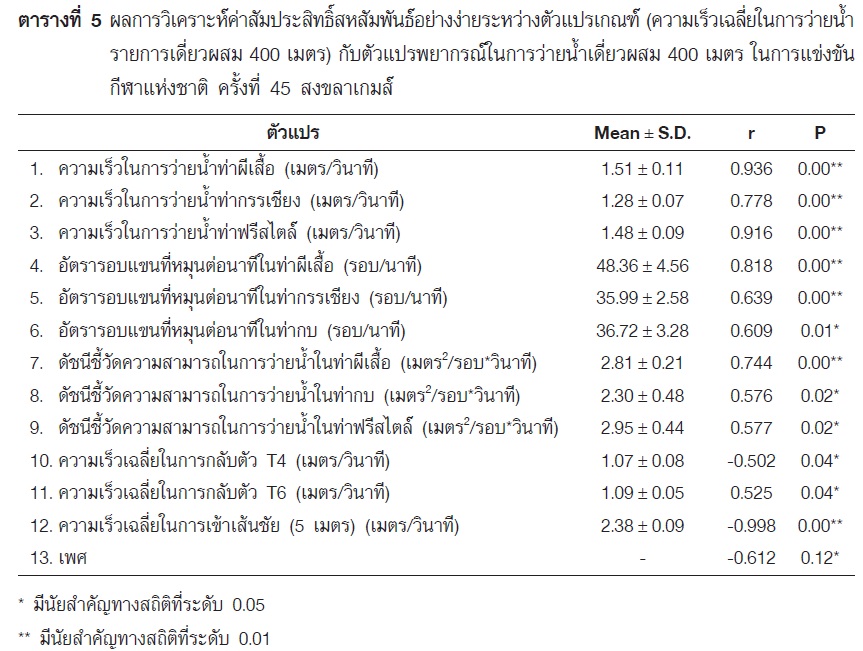การวิเคราะห์กลยุทธ์เฉพาะในการว่ายน้ำรายการเดี่ยวผสม 200 และ 400 เมตร ของนักกีฬาว่ายน้ำในการแข่งขันกีฬาแห่งชาติ ครั้งที่ 45
Main Article Content
บทคัดย่อ
วัตถุประสงค์ : เพื่อศึกษาและเปรียบเทียบกลยุทธ์เฉพาะในนักกีฬาว่ายน้ำชายและหญิง และสร้างสมการพยากรณ์ทำนายตัวแปรที่ส่งผลต่อความสามารถในการว่ายน้ำรายการเดี่ยวผสม 200 เมตร และ 400 เมตร ในการแข่งขันกีฬาแห่งชาติ ครั้งที่ 45
วิธีดำเนินการวิจัย : กลุ่มตัวอย่างเป็นนักกีฬาว่ายน้ำ จำนวน 16 คน (ชาย 8 หญิง 8) ที่เข้าร่วมการแข่งขันรอบชิงชนะเลิศรายการเดี่ยวผสม 200 เมตรและ 400 เมตร ในการแข่งขันกีฬาแห่งชาติ ครั้งที่ 45 บันทึกภาพการแข่งขัน โดยใช้กล้องบันทึกภาพที่ความถี่ 50 เฮิร์ซแบบหมุนได้จำนวน 1 ตัว วิเคราะห์ข้อมูลกลยุทธ์เฉพาะของความสามารถในการว่ายน้ำโดยโปรแกรม Dartfish เปรียบเทียบค่าเฉลี่ยและส่วนเบี่ยงเบนมาตรฐานของตัวแปรระหว่างเพศโดยใช้สถิติ t-test แบบสองกลุ่มที่เป็นอิสระต่อกัน วิเคราะห์การถดถอยเชิงเส้นแบบพหุคูณ เพื่อพยากรณ์ตัวแปรที่ส่งผลต่อความสามารถในการว่ายน้ำ ทดสอบความมีนัยสำคัญทางสถิติที่ระดับ 0.05
ผลการวิจัย : กลยุทธ์เฉพาะที่นักกีฬาใช้ในการแข่งขันรายการเดี่ยวผสม 200 เมตร และ 400 เมตร ระหว่างนักว่ายน้ำชายและหญิงมีรูปแบบเดียวกัน โดยนักกีฬาชาย มีค่าเฉลี่ยในการว่ายน้ำดีกว่านักกีฬาหญิง ความเร็วเฉลี่ยในการว่ายน้ำมีค่าสูงสุดในท่าผีเสื้อ ฟรีสไตล์ กรรเชียง และท่ากบ ตามลำดับ ความเร็วเฉลี่ยในการว่ายน้ำ และอัตรารอบแขนที่หมุนต่อนาที ในการแข่งขันรายการเดี่ยวผสม 200 เมตร มีค่าสูงกว่า 400 เมตร (p<0.05) อัตรารอบแขนหมุนต่อนาทีที่เพิ่มขึ้น ทำให้ดัชนีชี้วัดความสามารถในการว่ายน้ำเพิ่มขึ้น ในทางกลับกัน เมื่อระยะทางที่ได้จากการหมุนแขนในครั้งเดียวเพิ่มขึ้นอัตรารอบแขนที่หมุนต่อนาทีจะลดลง ดัชนีชี้วัดความสามารถในการว่ายน้ำระยะทาง 200 เมตร มีค่าเฉลี่ยสูงกว่า ระยะทาง 400 เมตร อย่างมีนัยสำคัญทางสถิติ (p<0.05) สมการพยากรณ์เชิงเส้น พบว่า ความเร็วเฉลี่ยในการว่ายน้ำเดี่ยวผสม 200 เมตร = –0.313 + (0.549* ความเร็วในการว่ายท่าฟรีสไตล์) + (0.551* ความเร็วเฉลี่ยในการกลับตัวจากท่าผีเสื้อไปท่ากรรเชียง) และ ความเร็วเฉลี่ยในการว่ายน้ำเดี่ยวผสม 400 เมตร = –0.010 + (0.337* ความเร็วในการว่ายน้ำท่าผีเสื้อ) + (0.294* ความเร็วในการว่ายน้ำท่ากรรเชียง) + (0.250* ความเร็วในการว่ายน้ำท่าฟรีสไตล์) + (0.035* ดัชนีชี้วัดความสามารถในการว่ายน้ำท่ากบ)
สรุปผลการวิจัย : กลยุทธ์เฉพาะของนักกีฬาที่ใช้ในการว่ายน้ำรายการเดี่ยวผสมระยะทาง 200 เมตร และ 400 เมตร มีรูปแบบเดียวกันในนักว่ายน้ำชายและหญิง โดยที่ความเร็วเฉลี่ยในการว่ายน้ำมีค่าสูงสุดในท่าผีเสื้อและต่ำสุดในท่ากบ สมการพยากรณ์ความเร็วเฉลี่ยในการว่ายน้ำรายการเดี่ยวผสม 200 เมตร และ 400 เมตร แสดงให้เห็นถึงปัจจัยสำคัญที่สามารถใช้ในการทำนายความสามารถในการว่ายน้ำและใช้เป็นข้อมูลสำหรับการวางแผนการฝึกซ้อมสำหรับนักกีฬารายบุคคลต่อไป
Article Details
เอกสารอ้างอิง
Barbosa, T. M., Fernandes, & Vilas-Boas, J. (2005). Evaluation of the energy expenditure in competitive swimming strokes. International Journal of Sports Medicine, 27(11), 894-899.
Bonifazi, M., Sardella, F., & Lupo, C. (2000). Preparatory versus main competitions: differences in performances, lactate responses and pre-competition plasma cortisol concentrations in elite male swimmers. European Journal of Applied Physiology, 82(5-6), 368-373.
Cossor, J., & Mason, B. (2001). Swim start performances at the Sydney 2000 Olympic Games. Paper presented at the ISBSConference Proceedings Archive.
Laffite, L. P., Vilas-Boas, J. P., Demarle, A., Silva, J., Fernandes, R., & Louise Billat, V. (2004). Changes in physiological and stroke parameters during a maximal 400-m free swimming test in elite swimmers. Canadian Journal of Applied Physiology, 29(S1), S17-S31.
McCabe, C. B., Psycharakis, S., & Sanders, R. (2011). Kinematic differences between front crawl sprint and distance swimmers at sprint pace. Journal of Sports Sciences, 29(2), 115-123.
Mercadé, J., B. F., Ortiz, E. M., & Contreras, G. L. (2007). Effects of different distance of swim on physiological and technical performance in front crawl swimming. Paper presented at the Swimming Science I.
Morais, J. E., A., Marinho, D., & Barbosa, T. M. (2012). Linking selected kinematic, anthropometric and hydrodynamic variables to young swimmer performance. Pediatric Exercise Science, 24(4), 649-664.
Morais, J. E., Marques, M. C., & Barbosa, T. M. (2014). Longitudinal modeling in sports: Young swimmers’ performance and biomechanics profile. Human Movement Science, 37, 111-122.
Okuno, K. (2003). Stroke characteristics of world class male swimmers in free style events of the 9th FINA world swimming championships 2001 Fukuoka. Biomechanics and Medicine in Swimming, 162.
Robertson, E. Y., Pyne, D. B., Hopkins, W. G., & Anson, J. M. (2009). Analysis of lap times in international swimming competitions. Journal of Sports Sciences, 27(4), 387-395.
Saavedra, J. M., Escalante, Y., Garcia-Hermoso, A., Arellano, R., & Navarro, F. (2012). A 12-year analysis of pacing strategies in 200-and 400-m individual medley in international swimming competitions. The Journal of Strength & Conditioning Research, 26(12), 3289-3296.
Silva, A. J., V. M., Saavedra, J., Perl, J., Marinho, D. A. (2007). The use of neural network technology to model swimming performance. Journal of Sports Science & Medicine, 6(1), 117.
Thompson, K., Haljand, R., & MacLaren, D. (2000). An analysis of selected kinematic variables in national and elite male and female 100-m and 200-m breaststroke swimmers. Journal of Sports Sciences, 18(6), 421-431.
Thompson, K., MacLaren, D., Lees, A., & Atkinson, G. (2003). The effect of even, positive and negative pacing on metabolic, kinematic and temporal variables during breaststroke swimming. European Journal of Applied Physiology, 88(4-5), 438-443.
Tor, E., Pease, D. L., Ball, K. A., & Hopkins, W. G. (2014). Monitoring the effect of race-analysis parameters on performance in elite swimmers. International Journal of Sports Physiology and Performance, 9(4), 633-636.
Toubekis, A. G., Tsami, A. P., Smilios, I. G., Douda, H. T., & Tokmakidis, S. P. (2011). Training-induced changes on blood lactate profile and critical velocity in young swimmers. The Journal of Strength & Conditioning Research, 25(6), 1563-1570.
Welsh, A. H., & Knight, E. J. (2015). “Magnitudebased inference”: A statistical review. Medicine and Science in Sports and Exercise, 47(4), 874


